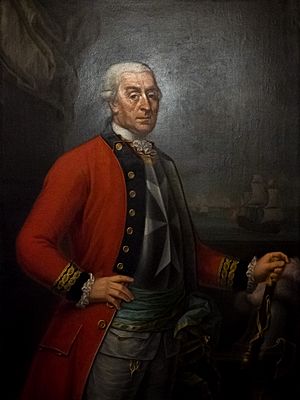Giovanni Battista Tommasi facts for kids
Quick facts for kids
Giovanni Battista Tommasi
|
|
|---|---|
 |
|
| Grand Master of the Order of Saint John | |
| In office 11 March 1803 – 13 June 1805 |
|
| Preceded by | Nikolay Saltykov |
| Succeeded by | Innico Maria Guevara-Suardo |
| Personal details | |
| Born | 6 October 1731 Cortona, Kingdom of Naples |
| Died | 13 June 1805 Catania, Kingdom of Sicily |
| Resting place | Catania |
| Nationality | Italian |
| Military service | |
| Allegiance | |
Giovanni Battista Tommasi was an Italian nobleman. He became the 73rd leader, or Grand Master, of the Order of Malta. He was born in Cortona on October 6, 1731. He passed away in Catania on June 13, 1805.
Contents
Life of Giovanni Battista Tommasi
Giovanni Battista Tommasi was born in the Kingdom of Naples. When he was young, he joined the Knights Hospitaller. At age 12, he was sent to Malta to serve as a page. He worked for Grand Master Emmanuel Pinto.
After his time as a page, he joined the Order's navy. He was known as one of their best sailors. Later, he became the commander-in-chief of the Order's navy. He also held many important administrative roles. In 1784, he became a minister to the Grand Master.
The Order Faces Challenges (1798–1803)
In 1798, Napoleon Bonaparte captured Malta. The Grand Master at the time, Ferdinand von Hompesch zu Bolheim, stepped down. Tommasi and other knights had to leave the island. They were spread out across Europe.
Some members of the Order gathered in Russia. They chose Paul I of Russia as their Grand Master. However, the Pope did not agree with this choice. The Pope believed the Order could not be led by a married man. Also, Paul I was Russian Orthodox and had never been a member of the Order.
When Paul I died, his son Alexander I of Russia became Tsar. Alexander decided to end this unusual situation. He refused to be the Grand Master. Meanwhile, the British had taken control of Malta. The Allied nations agreed to bring the Order back. But the knights were still scattered. They could not meet to choose a new leader.
So, for this one time, the Pope would choose the new Grand Master. Each group of knights suggested a candidate. Tommasi, who was living in Messina at the time, was one of these candidates.
In September 1802, Pope Pius VII first offered the job to Bartolomeo Ruspoli. Ruspoli was a Roman prince. He had been a general of the Order's galleys. But Ruspoli was in Scotland and turned down the offer.
On February 9, 1803, Tommasi was chosen as Grand Master. This decision was supported by Alexander I and King Ferdinand of Naples. Tommasi officially began his role on March 11, 1803.
Leading the Order from Sicily (1803–1805)
Right after becoming Grand Master, Tommasi sent a representative to Malta. He asked the British to leave the island. This was in line with a peace agreement called the Treaty of Amiens. He also asked them to hand over the government palace in Valletta.
The British governor, Alexander Ball, replied on March 2, 1803. He said that some countries still did not recognize Malta's independence. So, Britain was allowed to keep troops there. He also said the palace was being used by British officials. Ball suggested Tommasi could use the Boschetta palace. But until it was ready, Tommasi should stay in Sicily.
In response, Tommasi called a meeting of the Order. It took place in Messina on June 27, 1803. He read the Pope's official letter about his election. Tommasi asked the Order to stay united. He wanted to make sure the Order would continue to exist.
Tommasi then moved to Catania in Sicily. He brought the Order's records and archives there. The Augustinian convent was used for their offices. Tommasi lived in a nearby palace. He died there on June 13, 1805, at age 74.
Before he died, he named Innico Maria Guevara-Suardo as the Order's temporary leader. Tommasi was buried at Catania Cathedral. He is also remembered at Cortona Cathedral, where a monument stands in his memory. His nomination was confirmed by the Pope. Suardo led the Order until his death in 1814. The Order was then led by temporary leaders until a new Grand Master was officially elected in 1879.
See also
 In Spanish: Giovanni Battista Tommasi para niños
In Spanish: Giovanni Battista Tommasi para niños

